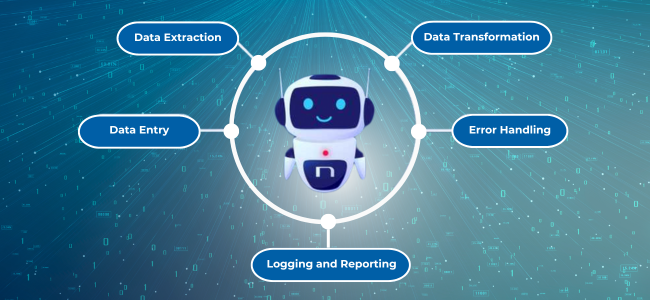Automating Data Entry with RPA Bots
Published on: Aug 13, 2024

Written by: Admin
Manual Data Entry Automation: Transferring Data Between Applications Using RPA Bots
Automate manual data entry and seamless transfer between apps with RPA bots. Reduce errors and save time by using automation to handle data without APIs.
The Challenges of Manual Data Entry
Manual data entry involves inputting data from one source into another by hand. This process is often plagued by several issues:
- Time-Consuming: Manual data entry requires significant time and effort, especially when dealing with large volumes of data.
- Error-Prone: Human errors, such as typos and incorrect entries, are common in manual data entry, leading to data inaccuracies.
- Resource-Intensive: Manual data entry tasks require dedicated personnel, diverting resources from more strategic activities.
- Inconsistency: Variations in data entry methods and standards can lead to inconsistencies and data quality issues.

The Solution: RPA for Data Entry Automation
Robotic Process Automation (RPA) offers a robust solution to automate manual data entry. RPA bots can mimic human interactions with software applications, transferring data from one application to another without the need for APIs. This approach significantly enhances efficiency, accuracy, and consistency in data handling.
How RPA Bots Automate Data Entry
- Data Extraction: RPA bots can extract data from various sources, such as spreadsheets, databases, emails, and web pages. Using techniques like Optical Character Recognition (OCR), bots can even extract data from scanned documents and images.
- Data Transformation: Once the data is extracted, RPA bots can transform and format it as needed. This step ensures that the data meets the required standards and formats for the target application.
- Data Entry: RPA bots can navigate through the user interface of the target application and enter data into the appropriate fields. This involves mimicking user actions, such as typing, clicking, and selecting options from dropdown menus.
- Error Handling and Validation: RPA bots are equipped with error handling mechanisms to detect and correct errors during the data entry process. They can validate data against predefined rules and ensure accuracy before submission.
- Logging and Reporting: RPA bots maintain logs of their activities, providing a detailed record of the data transfer process. This feature enables monitoring, auditing, and reporting for compliance and performance analysis.
Example Use Case: Transferring Customer Data
Let's consider an example where a company needs to transfer customer data from an old CRM (Customer Relationship Management) system to a new one. Without an API integration, this task would typically involve manual data entry. Here's how an RPA bot can automate this process:
- Data Extraction: The RPA bot logs into the old CRM system and navigates to the customer records section. It extracts relevant data, such as customer names, contact details, and transaction histories, and stores it in a structured format.
- Data Transformation: The bot transforms the extracted data to match the format required by the new CRM system. This step may involve reformatting dates, standardizing address formats, and cleaning up data inconsistencies.
- Data Entry: The RPA bot logs into the new CRM system and begins the data entry process. It navigates to the appropriate sections, enters the customer data into the required fields, and saves the records.
- Error Handling: The bot checks for any errors or validation issues during the data entry process. If it encounters an error, it logs the issue, attempts to correct it, and retries the entry. If the error persists, it flags the record for manual review.
- Logging and Reporting: The RPA bot generates a report detailing the data transfer process, including the number of records processed, any errors encountered, and actions taken to resolve them.

Intelgic's RPA - Process Bot
Intelgic's RPA - Process Bot is a versatile tool designed to automate manual data entry and transfer tasks. Here’s how it can be leveraged for seamless data transfer between applications:
- User-Friendly Interface: The Process Bot offers an intuitive interface that simplifies the creation and management of automation workflows, even for users with minimal technical expertise.
- Advanced Data Handling: Process Bot supports advanced data extraction, transformation, and entry capabilities, ensuring accurate and efficient data transfer.
- Error Handling and Validation: The bot includes robust error handling and data validation mechanisms, ensuring data integrity and accuracy.
- Scalability: Process Bot can handle large volumes of data and scale to accommodate growing business needs, making it suitable for enterprises of all sizes.
- Integration: While APIs are not required, Process Bot can seamlessly integrate with existing business systems and applications, ensuring smooth and efficient data transfer.
Manual data entry is a tedious and error-prone task that can significantly impact business efficiency and accuracy. By leveraging RPA bots like Intelgic's Process Bot, businesses can automate the transfer of data between applications without relying on APIs. This approach enhances productivity, reduces errors, and frees up valuable resources for more strategic activities. Embracing RPA for data entry automation is a smart investment that can drive significant improvements in business operations.

